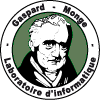Mixed languages
Résumé
Let T=ABC be an alphabet that is partitioned into three subalphabets. The mixing product of a word g over AB and of a word d over AC is the set of words w over T such that its projection onto AB gives g and its projection onto AC gives d. Let R be a regular language over T such that xbcy is in R if and only if xcby is in R for any two letters b in B and c in C. In other words, R is commutative over B and C. Is this property “structural” in the sense that R can then be obtained as a mixing product of a regular language over AB and of a regular language over AC? This question has a rather easy answer, but there are many cases where the answer is negative. A more interesting question is whether R can be represented as a finite union of mixed products of regular languages. For the moment, we do not have an answer to this question. However, we prove that it is decidable whether, for a given k, the language R is a union of at most k mixed products of regular languages.
